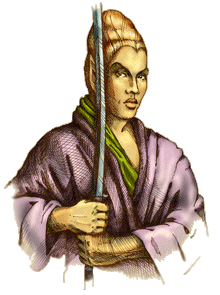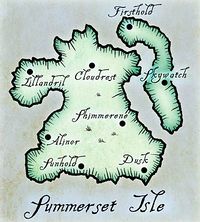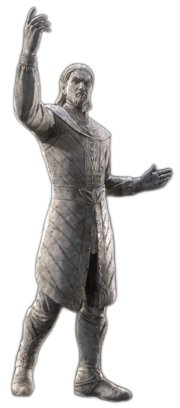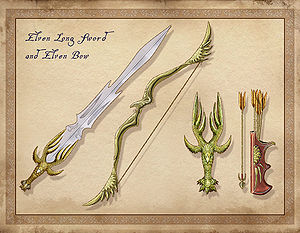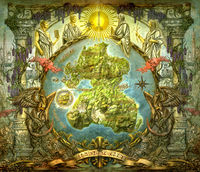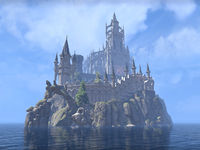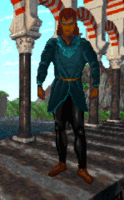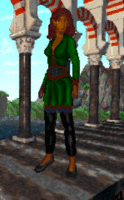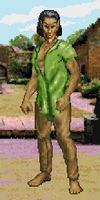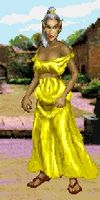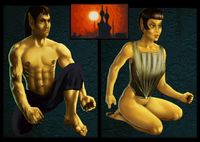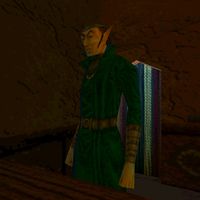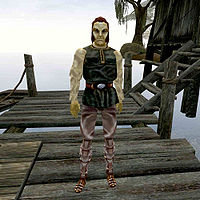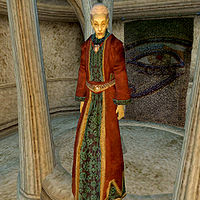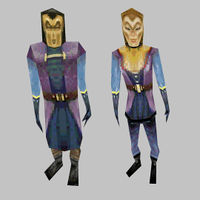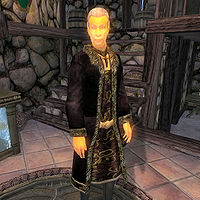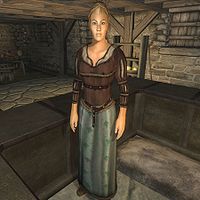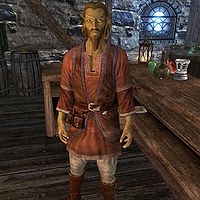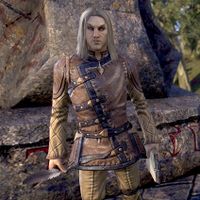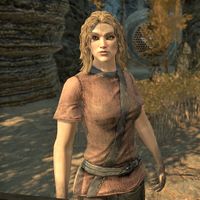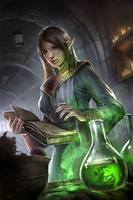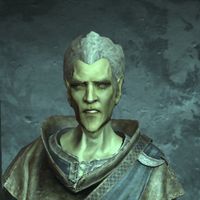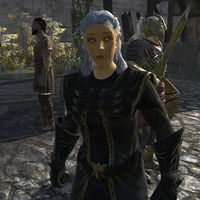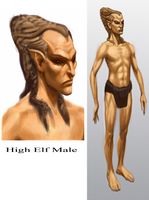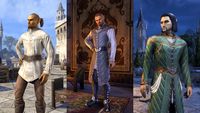Lore:Altmer
The Altmer, or self-titled "Cultured People", are a tall, golden-skinned race, hailing from Summerset Isle. They are also known as High Elves by the denizens of Tamriel,[1] or the more obscure term Salache.[2] High Elves are generally viewed as being proud or snobbish.[3] Altmer live two to three times as long as humans; with a 200-year-old Altmer being old and a 300-year-old Altmer being very, very old.[4] Altmer consider themselves to be the most civilized culture of Tamriel; the common tongue of the continent is based on Altmer speech and writing, and most of the Empire's arts, crafts, laws, and sciences are derived from Altmer traditions.[5][6]
The Altmer are the most strongly gifted in the arcane arts of all the races, and they are very resistant to diseases and immune to paralysis.[7] However, they are also somewhat vulnerable to magicka, fire, frost, and shock, which makes them very weak against their strongest point - magic.[8] They are among the longest living and most intelligent races of Tamriel, and they often become powerful magic users due to both their magical affinity and the many years they may devote to their studies.
History[edit]
Origins and Early Schisms[edit]
Altmer are thought to be the most direct, unaltered descendants of the original Aldmer elves,[5] and the transition from one to the other is not very clear. The Altmer seemed to have changed by staying the same. When the Aldmer left their home island of Aldmeris, most if not all of them settled first in the Summerset Isle.[5][9] The Maormer believe the Altmer to be a mongrel race, and that it is actually the Sea Elves who are directly descended from the "purest strain" of Aldmeri ancestors.[10] Much of their history is lost or hidden, but it is known that many unique ruins and structures, notably the Ceporah Tower, predate the Aldmeri arrival by at least several hundred years.[5] They likely warred with the Sload of Thras and other strange, unknown creatures for control of Summerset in ancient times.[5][11] At some point they came together and formed the Crystal Tower as a monument to the spirit of their race, and it was the pinnacle of magical learning until the construction of the Arcane University.[5]
Social clashes among the Aldmer would lead to a series of emigrations from Summerset Isle to regions all over Tamriel, notably under the prophet Veloth, which would lead to the great diversification of Elven races, such as the Chimer, Bosmer, Orsimer and Ayleids (exactly when and where the Dwemer and Snow Elves emerged is not clear, but they are believed to all have a common ancestry).[5][12][13][14] Many different, often corroborating legends claim that the changes of each race were the result of differences in their worship of deities.[12][15][16][17][18][19] The Maormer, or Sea Elves, of Pyandonea were at one time counted among these emigrant groups from Summerset, but tapestries in the Crystal Tower suggest that their divergence from the Aldmer took place before the Elves had quit Aldmeris – an account that had been accepted by both Altmer and Maormer sources by the middle Second Era.[20][10][21]
Altmer in High Rock and Hammerfell[edit]
One clan of Altmer, the Direnni, established a foothold in High Rock and rose to power there in the early First Era, founding the Direnni Hegemony. Strengthened by Ayleids fleeing the ascendant Alessian Order in Cyrodiil,[22] at its height the Hegemony incorporated parts of Skyrim and Hammerfell.[23] The number of Direnni Altmer was always small, and in High Rock the Altmer interbred with local Nedes, producing the Manmeri race who would later be known as the Bretons.[24][25] The Bretons assumed positions as stewards and administrators under the Hegemony,[24] and though the Direnni defeated an Alessian invasion at the climactic Battle of Glenumbra Moors in 1E 482,[22] they were so weakened in the victory that the emergent Breton nobility were able to force them to retreat from almost the whole of High Rock to the Isle of Balfiera – the site of the primordial Tower of Ada-mantia, which became known as the Direnni Tower.[24] The Direnni continued to rule Balfiera long afterwards as Castellans until the Warp in the West in 3E 417,[25][26] and retained a reputation as powerful mages, defeating a Redguard invasion of the isle in 1E 907.[24] Their clan stronghold in Summerset itself, however, had fallen into ruin by the middle of the Second Era.[27]
Colonies of Altmer existed in other parts of western Tamriel during the First Era, though these proved more short-lived. The Corelanya Clan established a foothold on the coasts of Hammerfell in the 6th century of the First Era, taking over the formerly Ayleid city of Salas En, and possibly participated in a larger Bosmeri trade network.[28] Said to be Daedra-worshippers, they were driven out and killed in 1E 853 by invading Ra Gada forces from Yokuda under the leadership of King Xakhwan.[29]
The Aldmeri Dominions and Imperial Rule[edit]
While mainland Tamriel experienced many problems and sagas during the First and early Second Era, the sea insulated the Altmer of Summerset from their problems, though they had their own limited internal conflicts as well as repeated, large-scale invasions from the Sload and Maormer to deal with.[5] In 2E 580,[30] however, amid the chaos of the Interregnum that followed the fall of the Second Empire, Queen Ayrenn of Summerset allied with the Bosmer of Valenwood and the Khajiit of Elsweyr in the Elden Accord to form the First Aldmeri Dominion.[31] The Dominion's propaganda decried the carelessness of Men and promoted the establishment of Elven rule across Tamriel, viewing the Aldmeri races as the only peoples with the "wisdom and restraint" to be its proper stewards. To that end, the Dominion fought the Three Banners War against the Daggerfall Covenant and Ebonheart Pact for control of mainland Tamriel.[32]
The First Aldmeri Dominion ultimately failed in this endeavor and broke apart. A Second Dominion was established in 2E 830 following Altmer intervention in a dynastic dispute in Valenwood. The Second Dominion once more allied the Altmer with the Bosmer and Khajiit, but also with the Maormer – usually their hereditary enemies.[33] Even this expanded alliance could not stand against the forces of Tiber Septim, however, who crushed the Dominion with the help of the Numidium and finally brought the Summerset Isle into the Imperial fold in 2E 896.[34][35] The Maormer, for their part, soon resumed hostilities, attacking and threatening to conquer Summerset in the War of the Isle of 3E 110. The Altmer had to accept assistance from the Septim Third Empire to survive.[5] The Altmer remembered these incidents with shame and horror, and they likely contributed to social unrest among their youth later in the Third Era.[5]
The Fourth Era[edit]
The Oblivion Crisis of 3E 433 proved an even more traumatic moment for the Altmer. As Daedra overran Tamriel, the unnatural turmoil of the seas killed many of the Altmer fleeing the mainland to Summerset, and wrecked the ports that would have received them. The Crystal Tower briefly served as a stronghold for the surviving refugees in Summerset until it, too, was destroyed by a powerful Daedric spell.[36] A group named the Thalmor, originally an obscure bureau for the preservation of Altmeri heritage, had played an important role in the governments of the First and Second Dominions.[37][33] Following the chaos of the Crisis, an extremist cabal of Altmer supremacists now assumed this name and claimed credit for saving the Altmer from extinction using "deep and subtle magicks".[38] In 4E 22, the re-formed Thalmor seized power in Summerset outright and deposed the Altmer monarch, renaming the province Alinor.[39][40] Soon afterwards, in 4E 29, a faction friendly to the Thalmor took over Valenwood and formed a new union with the Altmer, establishing the Third Aldmeri Dominion.[39]
The Third Dominion proceeded to break off all contact with the Empire, and the Altmer lands remained silent to the outside world for some seventy years as the Thalmor consolidated their power.[39] A grim demonstration of the ruthlessness of the Thalmor in this pursuit – and the continuing resistance to their rule among some Altmer – was the Night of Green Fire in 4E 42, in which a group of Altmer dissidents were massacred by Thalmor mages at Sentinel.[41] At any rate, the Thalmor's sway continued to expand. After Nirn's moons vanished in the Void Nights of 4E 98–100, they claimed credit for their restoration and persuaded the Khajiit of Elsweyr to ally once more with the Aldmeri Dominion in 4E 115. Finally, the Thalmor turned their sights on the Empire itself. From 4E 171 to 175 the Dominion fought the Great War against the Empire, inflicting a series of punishing defeats that led to the signing of the White-Gold Concordat, which disbanded the Blades and banned the worship of the man-god Talos across the Empire.[39] With the Empire in turmoil from a civil war in Skyrim abetted by the Thalmor and the possible assassination of Emperor Titus Mede II,[42][43] the Altmer had attained a position of substantial power in Tamriel by 4E 201, though much remained unclear about the situation in Alinor itself.
Society and Religion[edit]
At the time the Crystal Tower was built in the Merethic Era, the Elves of Summerset had a relatively egalitarian society, though social stratification slowly developed into a rigid hierarchy of classes over the millennia.[5] The Wise (teachers and priests) became the highest echelon, followed by Artists, Princes, Warriors, Landowners, Merchants, Workers, and enslaved beasts such as Goblins.[5] Early literature by man painted the High Elves in poor light, though the impartiality of these accounts is questionable. It was suggested that the Altmer practiced eugenic infanticide, putting to death nine in ten of their newborns due to impurities, that Altmeri names are simply combinations of numbers in their own language, and that Altmer culture revolves around displaying social status.[33] Some of this has basis in fact; Altmer born with deformities or impurities are often – though not always[UOL 1] – abandoned by their parents as "hulkynd" (sometimes to be raised by priests of Stendarr),[44] and the full name of an Altmer is relatively extensive, detailing their patrilineal and matrilineal histories in addition to the history of their clan.[45]
Religion and Philosophy[edit]
The creation myth of the Altmer begins before the start of the Dawn Era and the beginning of time: the primordial force of Anu, stasis or order, created Anuiel, the soul of all things, so it could know itself.[46][47] Anuiel in turn created Sithis for the same purpose, who was the force of change and chaos and the sum up of all limitations, and their interrelation created the Aurbis, where the Original Spirits, the Aedra and Daedra, emerged before the creation of the Mundus.[46][48] The ancient Aldmer believed they are the relatively feeble descendants of the Aedra ("Aedra" roughly translates to "ancestor spirit"), aspects of those Aedra who populated the Mundus so that it might last despite Lorkhan's deception.[46]
As their hierarchical society developed, the lower classes stopped worshipping their own "lesser" Aedra in favor of those claimed by their social "betters".[5] Thus the Altmer pantheon slowly formed around the most popular and well-known of the Aedra, many of whom would later be incorporated into the Nine Divines.[5][46][49] The transition and choices have not gone without detractors.[5] The principal Eight are Auri-El, Magnus, Trinimac, Y'ffre (or Jephre[50]), Xarxes, Mara, Stendarr, and Syrabane – though any limitation to eight is unrecognized by Altmer outside the Empire – with significant additional cults dedicated to Phynaster and Lorkhan.[51] The numbers three, five, and eight are noted to be sacred numbers in Altmeri culture.[52][53]
In this developed form, Altmer religion venerates Auri-El as the soul of Anuiel. Auri-El allowed Lorkhan's creation of the mortal world in a moment of weakness, an enormity that severed the Aldmer from their eternal spirit world. Realizing his folly, he led their armies to defeat the Trickster God and establish the first Altmer kingdoms, Altmora and Old Ehlnofey, before ascending into heaven.[49] The Altmer aspire to follow him and join their Aedric ancestors among the stars.[49][54] Xarxes is believed to have been a scribe or priest of Auri-El who attained godhood, and originated and preserves the intricate structure of Altmer society.[55][56] He is said to keep records of the lives of every Altmer and of all the bonds of lineage that connect them,[55] and his scribe-priests are professed to preserve the knowledge of an ancient and otherwise forgotten language.[56] The priests of Auri-El teach that the Hand of Auri-El, the Eye of Magnus, the Arm of Trinimac, the Bones of Y'ffre, the Mouth of Xarxes, and the Heart of Mara form a single "divine body" which must be venerated as one, and with which the Altmer themselves are one.[57]
Stendarr's role in Altmeri myth is that of an apologist for Men.[49] Views on Stendarr are sharply divided: some Altmer reject his worship owing to this connection, while others venerate him for undertaking the "heavy burden" with compassion and mercy.[58][59] The popular hymn Praise Be includes a verse of praise for Stendarr, which is absent from the circulated written edition.[60][61] The roots of the Altmer superstition holding that the number two is inauspicious likely also lie in the belief that it is the "number of Man".[62] In the Fourth Era, the Thalmor have made it their objective to eradicate the cult of the Man-turned-god Talos throughout Tamriel.[39]
A priestly hierarchy oversees Altmer worship of the Aedra. Some priests are monastics, devoting themselves to peace and meditation in monasteries led by Aldarchs.[63][64] Others serve at public temples, where they instruct acolytes.[57] Ascendant Curates are responsible for the refinement, conferral and destruction of calians (a cultural talisman in the Altmeri culture, given to an Altmer upon turning eighteen, the age of majority. The talisman typically serves as a symbol of an Altmer's right to participate in society) ,and preside over the expulsion and admission of particular mer from and into Altmer society.[65][66] Though Daedric cults also exist among the Altmer,[67] whose ambition and magical prowess sometimes tempt them to seek the powers of Oblivion,[68] Daedra worship is severely reprobated in civil society.[69] Moreover, at least at the time of the Three Banners War, the authorities in Summerset viewed the living gods of the Dunmer Tribunal Temple as enemies of the state.[70]
According to the Aldmeriad, the great origin saga of the Elves, written by the Xarxes, Altmer are expected to honor their ancestors by honoring their own lives. He put an emphasis on the importance of the Divine Spark and urged Altmer to keep records of their lives as a sacred duty in form of an Oghma, an everscriven scroll which should memorialize their lives.[71]
Some Altmeri individuals, such as Saint Ohmandil and Saint Terilde are revered as saints. Items associated with them and their remnants are occasionally kept as relics.[72][73][74]
Praxis[edit]
At an Altmer's coming of age, they are granted a calian, a sphere of aetherquartz crystal representing their honor and social status.[65][75] The aetherquartz in calian spheres is polished using ground pumice and ocean sand.[76] Calians are considered to be "praxic talismans".[77] Mer who have committed some particularly grievous crime against Altmer law are termed "ousters" and "apraxics". While ousters are simply banished from their homes,[78] apraxics are treated more severely: their calians are ceremonially shattered by a curate and it is wholly forbidden for Altmer in good standing to speak to them.[79][77] Some apraxics labor for years to restore their status, as part of which they must painstakingly repair their own calian,[65][80] while others choose to remain in exile. Nonetheless, in the middle of the Second Era subversive literature written by aprax mer gained wide currency among young Altmer on Summerset Isle,[79] and provoked some of them to engage in revolutionary activity.[77] This questioning of Altmer customs coincided with reforms introduced by Queen Ayrenn after the founding of the First Aldmeri Dominion, including the end of Summerset's longstanding isolation and the opening of its borders to other races and cultures, which provoked heated debate and political maneuvering.[81][82][83]
Alaxon[edit]
One of the dominant philosophies of the Altmer of Summerset is the "Path to Alaxon". Alaxon is the state of perfection that every High Elf strives for. The Path to Alaxon represents the approach Altmer take to achieve that state. Practice of the Path requires intense dedication and concentrated effort.[84] Those who are judged to have attained a degree of perfection are granted an alaxon sphere, which, like calians, may be destroyed if they are judged to have fallen from it.[85] The Path to Alaxon is reflected in Summerset's characteristic architecture, which builds on the aesthetic practice of past architects in a sequential process of refinement.[UOL 2]
Law and Government[edit]
Altmer society was highly stratified by the middle of the Second Era. The monarch of Summerset ruled as sovereign with the advice of the College of Sapiarchs, an elite and highly selective scholarly institute,[86] and was sometimes represented by a viceroy titled the Proxy Queen or King.[87] The monarch descended from an almost continuous line of royalty extending back to the Merethic Era.[88] Their behavior was regulated by a set of written precedents known as the Scrolls of Praxis, whose chief interpreters were the Sapiarchs: these formed part of a broader system of inherited norms termed the Ceremoniarchy.[89][30] The heir to the throne was required to study the Ceremoniarchy for 3,555 days in the Sapiarchs' Labyrinth before they could take the crown,[86] and royal decrees were issued in its name.[81] Hereditary nobles termed kinlords and kinladies held many of the Altmer lands in fief. Altmer royalty were assisted by lieutenants titled vicereeves,[90] while cities that served as county seats were administered by canonreeves, civil officials equivalent to mayors in other cultures.[91]
The Divine Prosecution administers secular and religious justice,[92] and is made up of jurisreeves overseeing investigations and rank-and-file justiciars. Jurisreeves travel and deliberate in groups of three, each with distinct responsibilities: a revelator-naganwe to conduct magical inquiries, an admanen to serve as an inspector, and a thalmilan who would weigh the evidence and render a verdict.[62] The jurisreeves may have originated as a religious order.[93] Under Queen Ayrenn's First Aldmeri Dominion, executive responsibilities were increasingly assumed by the Thalmor, originally a bureau for the protection of Altmeri heritage.[37] The Thalmor incorporated the Divine Prosecution as a division at that time,[94] but the Prosecution existed long before the Thalmor's rise to power.[95]
The Altmer stringently regulate traffic into Summerset, and they have banned the import of such foreign goods as books, foods and perfumes in the past.[96] At the time of the First Aldmeri Dominion, the roster of forbidden books included mundane foreign writings judged to be "coarse", but the Divine Prosecution devoted particular attention to the suppression of literature promoting Daedra worship.[69]
Altmer politics was transformed in the early Fourth Era by the return of the Thalmor as a militant Elven supremacist group following the Oblivion Crisis. In the wake of the chaos caused by the Crisis and the fall of the Crystal Tower, the Thalmor overthrew the Summerset monarchy in a coup d'état.[40] Since then, officers of the Thalmor have taken direct charge of government functions such as diplomacy and espionage.[97]
Dissidence and Reform[edit]
As mentioned, whenever a substantial minority had some sort of socio-political or theological disagreement with the majority in Summerset in the Dawn Era, the dissidents would leave and usually go on to become other races of Mer. However, some time in the Merethic Era, one early group of dissidents who opposed the evolution to the traditional Altmer pantheon left the mainland of Summerset but remained quintessentially Altmer. The Psijics decided to follow the mystical Old Ways of Aldmeris and broke away to settle Artaeum, the third-largest island of the Isle.[5][35][98] Though they have often refused requests for dialogue from Alinor during their periods of seclusion from Tamriel,[99] the Psijics are not hostile to the other Altmer, and have offered their magic to protect Summerset in the past.[100] A leader of the Psijics, Ritemaster Iachesis, led them through the entire First Era and most of the Second, a span of some 3,500 years, giving some indication of the potential longevity of the Altmer.[98][101][102]
A subsequent bout of dissent occurred late in the Third Era, as younger Altmer again began pushing for social reform. These episodes were unusual in a society used to dissidents simply leaving.[5] But there were few if any places left to go at that point. Some change had taken place by the end of the Third Era: the Altmer once more allowed foreigners to come to their shores; some non-Altmer were even allowed to rise to the ranks of nobility in Summerset.[5] Many of these young rebellious Altmer turned to the Psijics for guidance, somewhat ironically consulting their distant past for a path to their future, while some militant radicals turned to terrorism.[5]
These tentative reforms were substantially reversed at the turn of the Fourth Era by the rise of the Thalmor, who instituted a policy of persecution and even open slaughter of dissidents and non-Elven races.[40] Numerous surviving Altmer dissidents were forced to flee to other parts of Tamriel, where they were frequently targeted by Thalmor assassins.[41][40] While many Altmer continue to disagree with the Thalmor in private, few venture to oppose them publicly.[103]
Culture[edit]
Holidays[edit]
- Feast of the Immortal Subterfuge
- A gold leaf mask mounted to a plaque may be displayed by Trinimac worshippers during this holiday.[104]
Fashion[edit]
Altmer fashion is influenced by the ideas of praxis and that all High Elves should appear as nobles, regardless of actual rank. Their clothing and accessories are often high end and are made to show their pride as Altmer. Silk is a common material. Canonreeves might be seen carrying silken parasols to guard from the sun's rays[105] and lace trimmed silk handkerchiefs on their person.[106] Neckerchiefs are also worn.[107] Some parasols bear minor enchantments allowing them to magically protect the area beneath and around the user from the weather.[108]
A kinlord may use fine beeswax to polish his boots.[109] Altmer in general often wear their boots overly tight so they can purposefully show off their ankles and so tend to have to use silver shoehorns to remove them.[110] A Kinlady wearing the styles of Skywatch or Firsthold may wear riding boots sporting diamond tipped silver spurs.[111] Should a high elven lady wish to swim in Summerset's pristine waters she may wear nothing more than a sensuous thong bathing suit gleaming with silver sequins.[112]
Gallery[edit]
Appearances[edit]
Miscellaneous[edit]
Notes[edit]
- The term "High Elf" originates in the works of J. R. R. Tolkien's legendarium.
See Also[edit]
- Altmer Names
- For a list of notable Altmer, see here.
- For game-specific information, see the Arena, Daggerfall, Battlespire, Morrowind, Shadowkey, Oblivion, Skyrim, Elder Scrolls Online, Legends, and Blades articles. Also see the Redguard category.
- High Elvish
Books[edit]
- A Case for Open Borders by Kinlord Andurion — A father's plea for his fellow Mer to open their minds
- Civility and Etiquette by Coristir — An Altmer guidebook outlining the correct social protocols when dealing with various peoples and beings
- Crafting Motif 1: High Elf Style by Doctor Alfidia Lupus — Beginning notes by Doctor Alfidia Lupus for a series of pamphlets on the major cultural styles of Tamriel
- The Great War by Legate Justianus Quintius — A soldier's summation of the major events before and during the Great War
- Guide to Altmeri Culture — An excerpt on Altmer dueling traditions
- Notes on Elven Architecture by Gastinus Florus, Masons' Guild Historian — Notes on Altmer architecture and its similarities to Ayleid design
- On the College of Sapiarchs by Adandora, Chronicler at Large — A treatise on the renowned College of Sapiarchs in Summerset
- The Price of Praxis by Ceruval Rolumaril — An Altmer recounts his life and the importance of his calian
- Protocol and Propriety in Summerset — A note outlining proper etiquette when dining with Altmer
- A Rejection of Open Borders by Kinlady Avinisse of Shimmerene — A member of the Summerset nobility explains her opposition to the Queen's Decree
- Rising Threat by Lathenil of Sunhold — A multi-volume series on the threat posed by the Thalmor
- Sages of the Crystal Tower by Nularan, Mages Guild Scribe — A Mages Guild scholar describes the renowned Sapiarchs of the Crystal Tower
References[edit]
- ^ Pocket Guide to the Empire, 1st Edition: Prologue — Imperial Geographical Society, 2E 864
- ^ The Wild Elves — Kiergo Chorvak
- ^ Notes on Elven Architecture — Gastinus Florus, Masons' Guild Historian
- ^ Ask Us Anything: Variety Pack 4
- ^ a b c d e f g h i j k l m n o p q r s Pocket Guide to the Empire, 3rd Edition: The Blessed Isle: Alinor and the Summersets — Imperial Geographical Society, 3E 432
- ^ Antecedants of Dwemer Law
- ^ High Elf racial abilities in Daggerfall
- ^ High Elf racial abilities in Morrowind and Oblivion
- ^ Pocket Guide to the Empire, 3rd Edition: All the Eras of Man, A Comprehensive History of our History — Imperial Geographical Society, 3E 432
- ^ a b The Chosen People of Aldmeris — Sealord Malleroth Of Pyandonea
- ^ Pocket Guide to the Empire, 3rd Edition: Other Lands — Imperial Geographical Society, 3E 432
- ^ a b The Changed Ones
- ^ Pocket Guide to the Empire, 3rd Edition: The Throat of the World: Skyrim — Imperial Geographical Society, 3E 432
- ^ A Short History of Morrowind — Jeanette Sitte
- ^ The True Nature of Orcs
- ^ The Anticipations — Anonymous
- ^ Vivec and Mephala
- ^ Father Of The Niben — Florin Jaliil
- ^ The House of Troubles
- ^ The Maormer of Pyandonea — Imperial Geographical Society
- ^ The False Revanchism of the Maormer — Hadendril of Skywatch
- ^ a b The Last King of the Ayleids — Herminia Cinna
- ^ The Daggerfall Chronicles — Ronald Wartow
- ^ a b c d The Bretons: Mongrels or Paragons? — Phrastus of Elinhir
- ^ a b Pocket Guide to the Empire, 1st Edition: High Rock — Imperial Geographical Society, 2E 864
- ^ The Warp in the West — Ulvius Tero
- ^ Events of Lauriel's Lament in ESO: Summerset
- ^ The Salas En Expedition — Lady Clarisse Laurent
- ^ Prince Haqmir's dialogue in ESO
- ^ a b Ayrenn: The Unforeseen Queen — Headmaster Tanion of the College of Aldmeri Propriety
- ^ Queen Ayrenn's dialogue in ESO
- ^ Welcome to New Aldmeri Irregulars — Aicantar of Shimmerene, Sapiarch of Indoctrination
- ^ a b c Pocket Guide to the Empire, 1st Edition: Aldmeri Dominion — Imperial Geographical Society, 2E 864
- ^ On Morrowind — Erramanwe of Sunhold
- ^ a b Brief History of the Empire v 1 — Stronach k'Thojj III
- ^ Rising Threat, Vol. I — Lathenil of Sunhold
- ^ a b Aicantar of Shimmerene Answers Your Questions — Aicantar of Shimmerene
- ^ Rising Threat, Vol. II — Lathenil of Sunhold
- ^ a b c d e The Great War — Legate Justianus Quintius
- ^ a b c d Rising Threat, Vol. IV — Lathenil of Sunhold
- ^ a b Legate Fasendil's dialogue in Skyrim
- ^ Thalmor Dossier: Ulfric Stormcloak
- ^ Events of To Kill an Empire in Skyrim
- ^ Manacar's dialogue in ESO
- ^ Lirendel's Family Shrine
- ^ a b c d The Monomyth
- ^ The Annotated Anuad
- ^ Sithis
- ^ a b c d Varieties of Faith... — Brother Mikhael Karkuxor of the Imperial College
- ^ Talomar's dialogue in ESO: Summerset
- ^ Varieties of Faith: The High Elves — Brother Mikhael Karkuxor of the Imperial College
- ^ Thoughts on the Sacred Numbers
- ^ Sheogorath Madness Cube antiquity codex entry in ESO
- ^ Vairabrian's dialogue in ESO: Summerset
- ^ a b Tu'whacca, Arkay, Xarxes — Lady Cinnabar of Taneth
- ^ a b Words and Power — Telenger the Artificer
- ^ a b Uurkar of Auri-El's dialogue in ESO
- ^ Rituals of the Harmonious Masters — Aritanwe of Lillandril
- ^ The Sounding Horn
- ^ Praise Be
- ^ Transcription of Praise Be as performed in ESO: Summerset
- ^ a b Jurisreeve Lorne's dialogue in ESO: Summerset
- ^ Monastic Firinore's dialogue in ESO
- ^ Monastic Nuleros' dialogue in ESO: Summerset
- ^ a b c The Price of Praxis — Ceruval Rolumaril
- ^ Aetherquartz Prayer Beads codex entries in ESO
- ^ Seeker Duperil and Seeker Veraye in ESO
- ^ The Banished Cells loading screen in ESO
- ^ a b Justiciar Tanorian's dialogue in ESO: Summerset
- ^ Sotha Sil's dialogue in ESO: Summerset
- ^ The Onus of the Oghma — Phrastus of Elinhir
- ^ Circlet of Saint Ohmandil item description in ESO
- ^ Saint Terilde's Fingerbone item description in ESO
- ^ Monastic Nenaron's dialogue in ESO
- ^ Aquiline Calian Sphere codex entry in ESO
- ^ Aetherquartz Prayer Beads codex entries in ESO
- ^ a b c Dialogue of the Mother of Rats in ESO: Summerset
- ^ Azarari's dialogue in ESO
- ^ a b Lanarie's dialogue in ESO: Summerset
- ^ Apraxic Decanter codex entries in ESO
- ^ a b An End to Isolation — Queen Ayrenn
- ^ A Case for Open Borders — Kinlord Andurion
- ^ A Rejection of Open Borders — Kinlady Avinisse of Shimmerene
- ^ Olnewil's dialogue in ESO: Summerset
- ^ Cases of the Divine Prosecution — High Magistrate Rinwaray, Bureaureeve of the Divine Prosecution
- ^ a b On the College of Sapiarchs — Adandora, Chronicler at Large
- ^ Valsirenn's dialogue in ESO: Summerset
- ^ Alinor Royal Palace loading screen in ESO: Summerset
- ^ Sages of the Crystal Tower — Nularan, Mages Guild Scribe
- ^ Vicereeve Pelidil's dialogue in ESO
- ^ Canonreeve Elquisa's dialogue in ESO: Summerset
- ^ The Divine Prosecution — Axulfa Giant-Slayer, Nord Cultural Exchange
- ^ Jurisreeve's Eye codex entries in ESO
- ^ Chief Justiciar Carawen's dialogue in ESO: Summerset
- ^ Please Respond, Your Beloved Aunt Daiyanni — Kinlady Daiyanni
- ^ Renzir's dialogue in ESO: Summerset
- ^ Events of Diplomatic Immunity in Skyrim
- ^ a b Fragment: On Artaeum — Taurce il-Anselma, 3E 400
- ^ The Mystery of Artaeum — Penewen, Advisor to the Court
- ^ Events of The Tower Sentinels in ESO: Summerset
- ^ 2920, The Last Year of the First Era — Carlovac Townway
- ^ Events of Lost in Translation in ESO: Summerset
- ^ Telarendil's dialogue in Blades
- ^ Gold-Leaf Trinimac Worship-Plaque item description in ESO
- ^ Canonreeve's Silken Parasol item description in ESO
- ^ Canonreeve's Silken Handkerchiefs item description in ESO
- ^ Summerset Silk Neckerchief item description in ESO
- ^ Clement Climate Picnic Parasol item description in ESO
- ^ Archon's Hive Boot Polish item description in ESO
- ^ Silver Shoehorn item description in ESO
- ^ High Kinlady's Diamond-Tipped Spurs item description in ESO
- ^ Swan-Satin Bathing Thong item description in ESO
Note: The following references are considered to be unofficial sources. They are included to round off this article and may not be authoritative or conclusive.
|
|||||||||||||||||||||||||||||||||||||||||||
